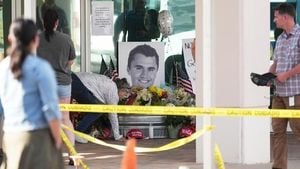On a bustling Wednesday afternoon, September 10, 2025, the Iztapalapa district of Mexico City—home to 1.8 million people—was rocked by a catastrophic explosion that would leave the city reeling for days. The disaster unfolded under a highway overpass, where a tanker truck carrying more than 13,000 gallons (49,500 litres) of liquefied petroleum gas (LPG) overturned and erupted in a fiery blast. The consequences were immediate and devastating: at least eight people lost their lives, nearly 100 more were injured, and a community was left grappling with the aftermath of one of the city’s worst industrial accidents in recent memory.
According to The New York Times, Mayor Clara Brugada quickly took to social media to share a preliminary list of the injured, noting that more than 20 were in critical condition and that some had suffered burns over more than half their bodies. As of the following day, at least 10 victims had been discharged from hospital, but the trauma remained palpable among those still fighting for their lives and their families waiting anxiously outside medical centers for news.
Eyewitness accounts and dramatic footage posted across social media captured the chaos in the moments following the explosion. People, their clothing charred and tattered, staggered from the flames, while neighbors and passersby rushed in to help evacuate the wounded. First responders and paramedics arrived swiftly, battling the blaze with hoses and foam as they attended to victims with severe burns. The shock wave from the blast damaged at least 32 vehicles, according to BBC, engulfing more than two dozen in flames and sending a thick cloud of smoke billowing across the southern expanse of the capital.
One particularly harrowing account reported by BBC involved a woman who suffered burns over 98% of her body after shielding her two-year-old granddaughter from the inferno. Children, including at least one baby, were among the injured, underscoring the indiscriminate nature of the tragedy.
The tanker responsible for the explosion bore the logo of Gas Silza, a subsidiary of Grupo Tomza, Mexico’s largest LPG distribution conglomerate. The company initially denied ownership of the vehicle, but later confirmed its involvement and stated that three insurance policies had been activated to cover the consequences of the accident. However, preliminary reviews by regulatory agencies, as reported by AFP, indicated that the truck’s operating permit was not in order and that the required insurance policy had not been received by federal safety officials. This discrepancy raised immediate questions about oversight and accountability in Mexico’s fuel transport industry, which relies on thousands of trucks like the one involved in the disaster to deliver propane to homes and businesses nationwide.
President Claudia Sheinbaum, addressing the nation the day after the explosion, offered condolences to the victims’ families and thanked the emergency services for their swift response. She also announced that the National Civil Protection Agency, the National Guard, and the Defence Ministry were assisting with rescue and recovery operations. In a statement, Sheinbaum said she had instructed her energy secretary to design new safety measures for transporting fuel, though she did not provide further details at that time. "It is a tragic accident. The prosecutor’s office is beginning investigations to determine what happened," Mayor Brugada said at the scene, according to The New York Times.
The Attorney General’s Office promptly launched a full investigation into the causes of the accident. Forensic experts, working in tandem with local and federal authorities, began the painstaking process of piecing together the sequence of events that led to the blast. Surveillance footage reviewed by municipal security officials showed people abandoning the vehicle with fire on their bodies, a grim testament to the explosion’s ferocity. Social media and television networks broadcast images of the burning truck, the flames reaching so high that smoke drifted as far as a nearby trolleybus station—one of the main public transport arteries in the city.
As the scale of the disaster became clear, authorities moved to reopen the highway linking Mexico City to Puebla by the evening of September 10, aiming to restore a semblance of normalcy amid the chaos. Yet, for many, the scars of the incident would linger. Groups of neighbors, some of whom had risked their own safety to pull victims from the fire, gathered outside hospitals and shared stories of courage and loss. One survivor, Paula Citlalli, recounted to El Gráfico that she was driving when a white fog suddenly enveloped the street, giving her only moments to react before the explosion changed everything.
The driver of the tanker was among those seriously injured and hospitalized, as confirmed by Mexico City Security Minister Pablo Vázquez Camacho. The company, Transportadora Silza, issued a statement calling the accident a "terrible event" and pledged to take "our social and legal responsibility for what has happened very seriously." This public acknowledgment, while necessary, did little to quell rising public anger and concern about the safety standards governing Mexico’s fuel transport sector.
The Iztapalapa explosion has reignited debate over the risks posed by fuel trucks traversing densely populated urban areas. As AFP and BBC noted, Mexico is no stranger to such tragedies. The nation still remembers the 2019 pipeline explosion in Tlahuelilpan that killed 137 people, an incident that underscored the dangers inherent in the country’s hydrocarbon infrastructure. The latest disaster has prompted calls for stricter regulation, improved oversight, and enhanced safety protocols to prevent similar catastrophes in the future.
In the wake of the explosion, families continued to cluster outside hospitals, clinging to hope for their loved ones. The city’s emergency response, involving hundreds of paramedics, firefighters, and soldiers—some victims even evacuated by helicopter—was widely praised. Yet, the sense of vulnerability lingers. As President Sheinbaum’s administration contemplates new safety measures, many are left wondering if enough will be done to safeguard communities from the ever-present hazards of industrial transport in one of the world’s most populous cities.
The Iztapalapa tragedy stands as a stark reminder of the human cost of industrial accidents and the urgent need for reform. For now, Mexico City mourns its dead, cares for its wounded, and looks ahead—determined, if nothing else, to demand answers and accountability.




